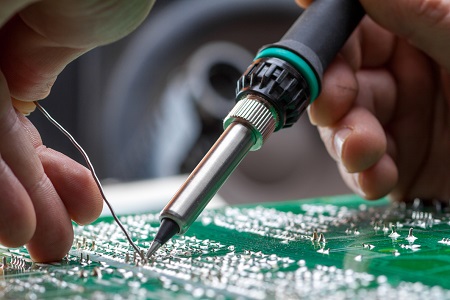In today’s modern world of semiconductor, it is utmost important to achieve the best and most precise PCB design service. Verification using ATE-socket has become an important step toward obtaining precise and accurate printed circuit board (PCB) tests. This verification that is performed to close the gap between product design and production helps to enforce that the different subunits work well under different circumstances. This blog explores how ATE-socket verification contributes to the excellence of printed circuit boards and how it affects quality and functionality, as well as semiconductor engineering development.
That is why, let’s consider how this process of verification helps to make the most of testing PCB and contributes to the development of new technologies.
1. Understanding ATE-Socket Verification
Automated Test Equipment (ATE) socket verification is a vital step in evaluating PCB performance. It involves testing the interaction between the ATE sockets and the PCB components under simulated operational conditions.
ATE-socket verification helps identify issues such as misalignment, signal integrity problems, and contact inconsistencies. By detecting flaws early, engineers can prevent costly design revisions and production delays. This process also ensures the PCB meets industry standards, ensuring reliability in real-world applications.
With ATE-socket verification, manufacturers can achieve consistent quality, making it an essential aspect of modern PCB testing protocols.
2. The Importance of Perfect PCB Testing
The testing of PCBs, must be done perfectly to make electronic devices successful. Defective products are produced when there are errors in the testing process and this affects the consumer trust and the brand image.
ATE-socket verification improves the testing process by offering an evaluation of the PCB’s behavior. It guarantees that every part works as expected and is consistent with the design requirements. This process reduces the chances of making mistakes, and thus increases production.
In industries such as telecommunications, healthcare and automotive industries where accuracy is of paramount importance, PCB testing becomes very crucial. Including ATE-socket verification helps to achieve high performance and durability of devices, which in turn helps to develop technologies.
3. ATE-Socket Verification and Signal Integrity
Signal integrity is a critical factor in PCB design and testing. ATE-socket verification ensures the preservation of signal integrity by minimizing electrical noise and interference.
During testing, ATE sockets evaluate the board’s ability to transmit signals without distortion. This verification ensures that signals maintain their strength and clarity across different conditions. By addressing issues like crosstalk, impedance mismatch, and signal loss, engineers can enhance PCB functionality.
This level of precision in signal integrity testing is essential for devices requiring high-speed data transmission, ensuring optimal performance in critical applications.
4. Impact on Semiconductor Engineering
ATE-socket verification has a direct impact on the progress of semiconductor engineering since it allows for precise evaluation of intricate layouts.
With the advancement in the complexity of PCBs, having multiple layers and complex circuits, testing procedures must also change. ATE-socket verification enables the engineers to solve issues such as high thermal loads and power variations to guarantee that the PCB will function optimally under different conditions.
This verification process helps in cutting down the time taken to bring semiconductor products to the market without compromising on quality. It promotes innovation because it gives manufacturers assurance of their designs, thus enabling the creation of new technologies.
5. Key Challenges in ATE-Socket Verification
Despite the numerous advantages of ATE-socket verification, it has its own drawbacks. One of the biggest challenges is to guarantee the correct orientation of sockets to the PCB components.
Other issues include the fast changing nature of PCB technologies, the high cost of testing equipment and strict time constraints. Engineers also need to consider degradation of sockets over time which can affect the test results.
However, there are some difficulties in using ATE-socket verification, but constant improvements in testing methods and equipment are helping to overcome these problems.
6. Best Practices for Effective Testing
To maximize the benefits of ATE-socket verification, manufacturers should follow best practices in the testing process. These include:Regular maintenance of ATE sockets to prevent wear-related inaccuracies.Using high-quality test equipment to ensure precision.Adopting automated testing solutions to reduce manual errors.Continuously training personnel to stay updated on the latest testing techniques. By implementing these strategies, manufacturers can achieve consistent results, improving overall PCB quality and reliability.
7. Applications Across Industries
ATE-socket verification is widely used in various industries such as communication, automotive, aerospace industries and among electronic consumer products.
In the consumer electronics, it puts to test smartphones, laptops and other gadgets to meet certain expected performance. In automotive, it aids in confirming pcb design board that are applied in safety related applications such as ADAS.
Likewise, in aerospace applications where reliability cannot be compromised, ATE-socket verification guarantees that all connected components will work optimally in adverse environments. Concerning its versatility, this element has an incredible value in the development of modern technologies.
8. Future of ATE-Socket Verification
The future of ATE-socket verification lies in leveraging AI and machine learning to enhance testing processes. These technologies can predict potential failures, optimize testing parameters, and reduce manual intervention.
Additionally, advancements in materials science will lead to more durable and efficient testing sockets. As the PCBs develop with new age technologies such as 5G and IoT getting imminent, the ATE-socket verification will remain indispensable to the success of the PCBs.
Some of the ways regarding which distinguished Semiconductor manufacturers can stay ahead by embracing innovation are discussed below.
Conclusion
ATE-socket verification is crucial for obtaining the best results in the testing of PCBs. It provides accuracy, dependability as well as uniformity in the manufacturing of sophisticated electronic products. Thus, this verification process will always be important as PCB design board technologies continue to improve to meet the needs of semiconductor engineering.
Challenges and best practices for ATE-socket verification show that manufacturers can maximize the benefits of this approach. It not only ensures the quality of the testing of PCB but also fosters the growth of new and efficient technologies for a brighter tomorrow.

